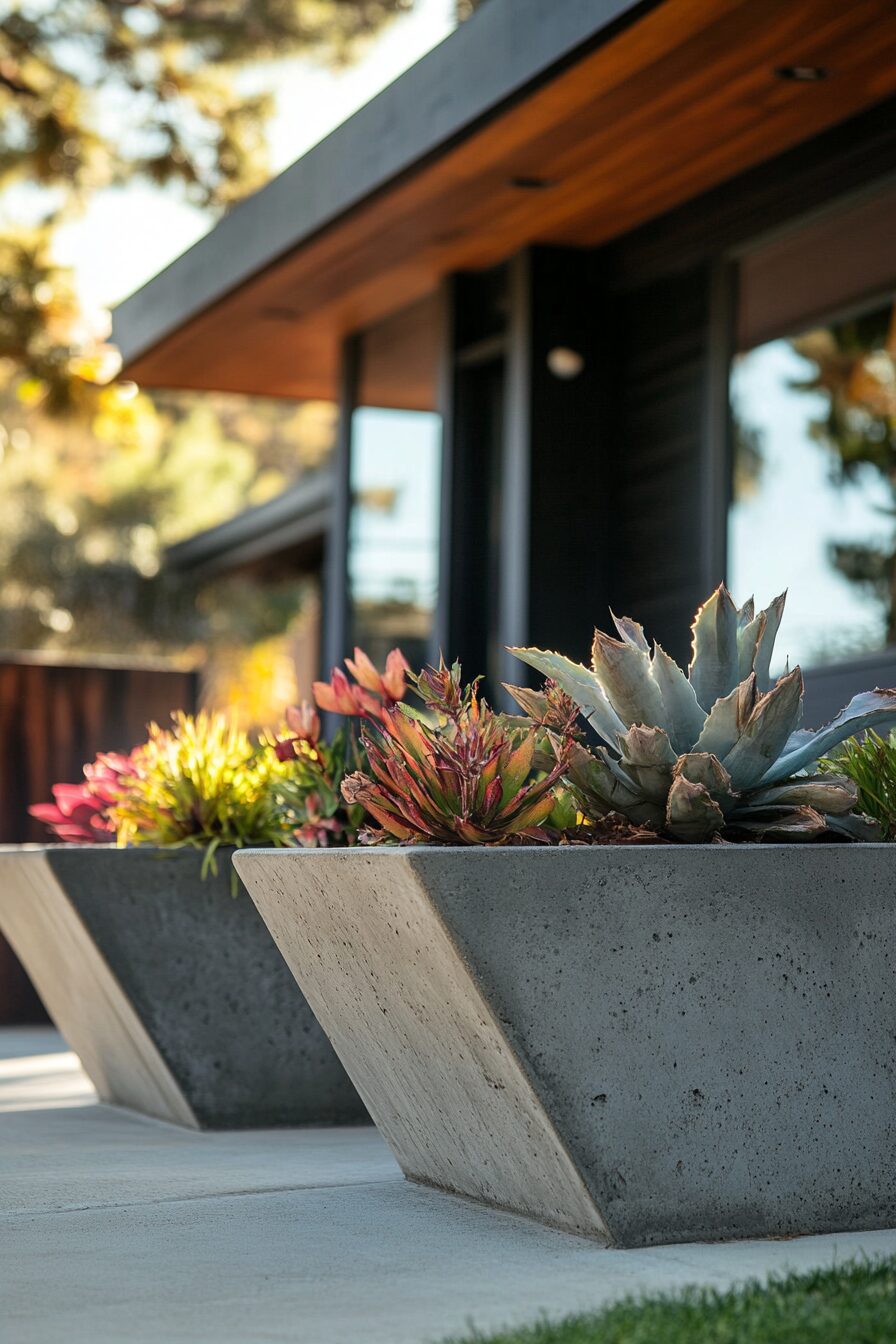Your front yard is the handshake your home offers to the world, and boring cookie-cutter flower beds just don’t cut it anymore.
Today’s trending gardens mix creativity with personality while keeping maintenance manageable.
Ready to turn that forgettable front yard into something spectacular?
These unique DIY approaches blend surprising materials, unexpected designs, and clever tricks that’ll have everyone slowing down to admire your handiwork.
✨Click to Get My 101 FREE Designer Room Ideas
Vertical Pallet Garden
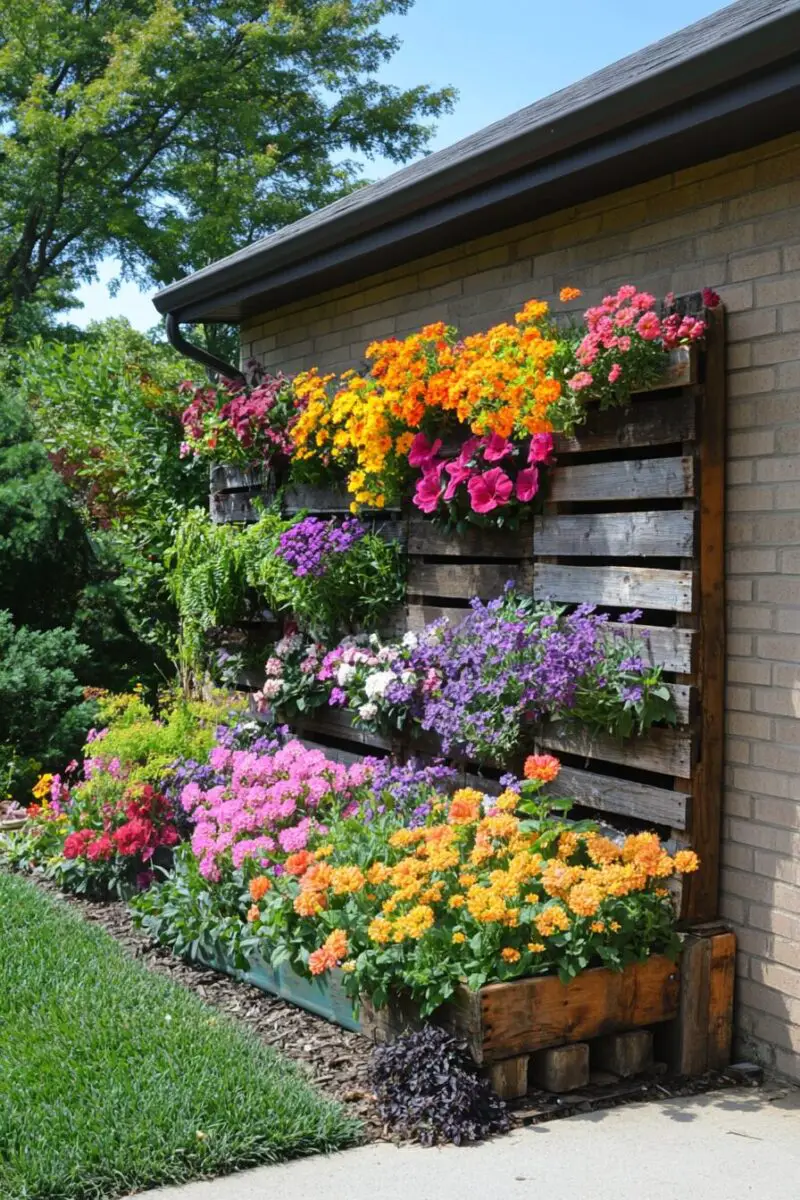
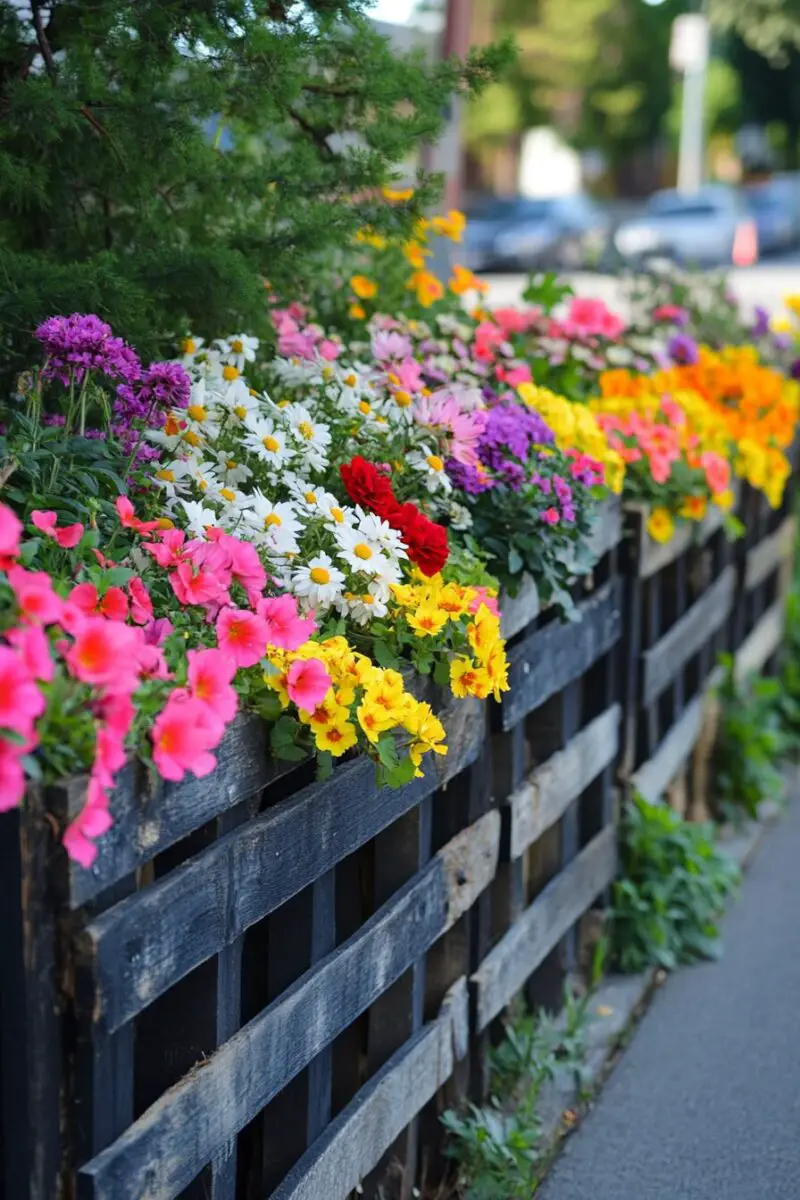
That old wooden pallet leaning against your garage isn’t junk – it’s your next conversation-starting garden feature.
Vertical pallet gardens transform ordinary front yards into architectural statements while maximizing limited space.
The rustic wood creates a perfect backdrop for cascading flowers and trailing vines that add dimension and movement to your garden.
Beginning this project is simpler than you might imagine – just secure a wooden pallet, sand rough edges, and add a backing of landscape fabric to create planting pockets.
Choose plants with varying heights, textures, and colors for maximum visual impact – think wave petunias, creeping thyme, and ornamental sweet potato vine for a stunning combination.
Position your completed pallet garden against a bare wall, fence, or even as a standalone feature to instantly add vertical interest to an otherwise flat landscape.
The beauty of pallet gardens lies in their versatility – paint the wood to match your home’s exterior or leave it natural for rustic charm.
Maintenance becomes a breeze as these elevated gardens reduce weeding and keep plants safely away from curious pets or wandering wildlife.
For additional drama, install small solar lights between plants to create a magical nighttime glow that highlights your handiwork after sunset.
Front yard pallet gardens work particularly well for homes with minimal yard space, allowing you to grow upward instead of outward.
As seasons change, simply swap plants to keep your vertical garden looking fresh – spring bulbs, summer annuals, and fall mums ensure year-round interest.
The best part?
This entire project costs virtually nothing if you source free pallets from local businesses that would otherwise discard them.
Remember to choose heat-tolerant plants for pallets that receive full sun exposure, as the wood can intensify heat during summer months.
Water your pallet garden more frequently than ground plantings since the vertical orientation causes faster drainage and drying.
With minimal investment and maximum impact, a vertical pallet garden transforms your front yard into a Pinterest-worthy showcase that expresses your creativity and gardening skills.
Tiered Wheelbarrow Display
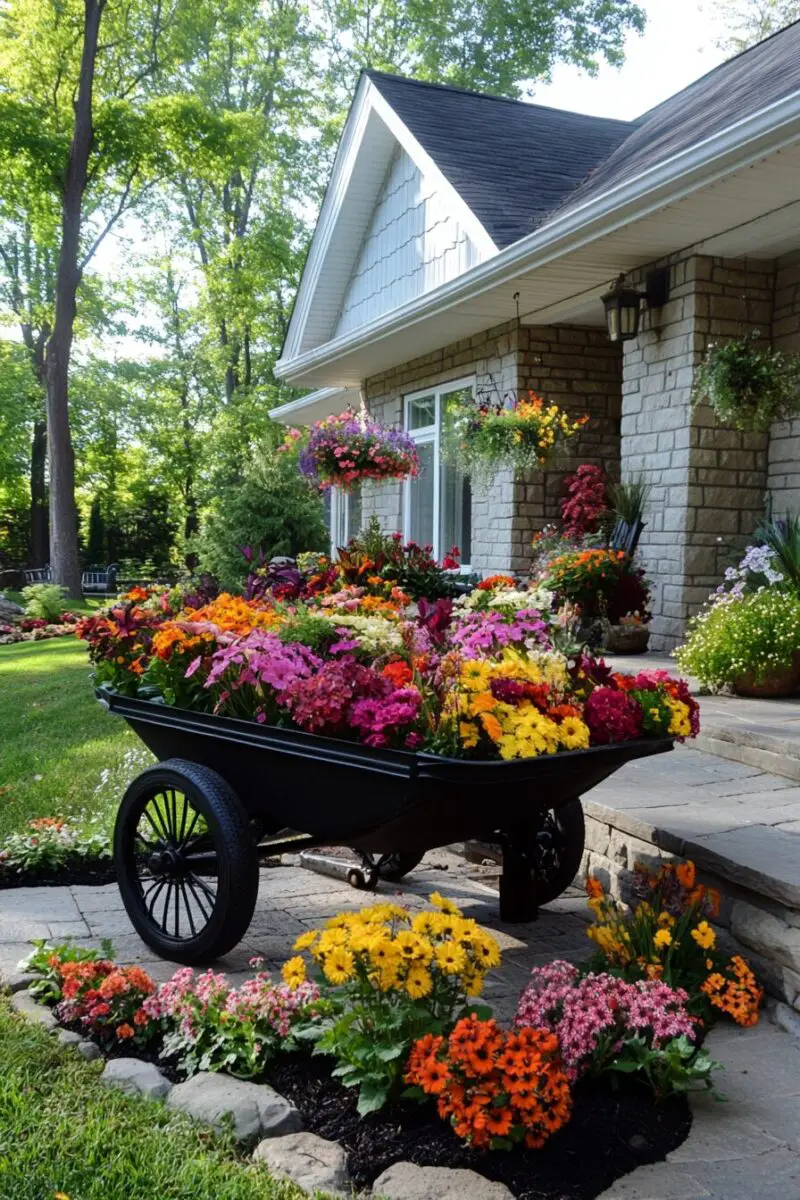
That rusty old wheelbarrow gathering cobwebs in your shed deserves a glamorous second life as the centerpiece of your front garden.
Tiered wheelbarrow displays create instant visual drama through unexpected elevation changes that naturally draw the eye upward.
The concept is brilliantly simple yet remarkably effective – position several wheelbarrows at different heights and angles, then fill them with cascading flowers for a waterfall effect of blooms.
Sourcing wheelbarrows becomes part of the fun as you hunt for different sizes, styles, and vintage finds at yard sales, flea markets, or online marketplaces.
Creating stability is crucial – use concrete blocks, large stones, or sturdy wooden crates to support each wheelbarrow at varying heights.
For maximum impact, position your tallest wheelbarrow at the back of the display and gradually step down in height toward the front, creating a natural viewing progression.
Color coordination transforms this idea from clever to spectacular – choose a cohesive color scheme or create deliberate contrast between the wheelbarrows and the flowers they contain.
Painting each wheelbarrow in coordinating or contrasting colors adds another dimension of visual interest before you even add a single plant.
Plant selection should include plenty of trailing varieties that will spill romantically over the edges – wave petunias, creeping phlox, and sweet potato vine create that desired cascading effect.
Strategically place the entire display where it’s visible from the street, perhaps flanking your front walkway or near your home’s entrance.
The elevated nature of this garden minimizes back strain during planting and maintenance, making it perfect for gardeners with mobility considerations.
Weather-beaten, rusty wheelbarrows often work better than pristine ones, as their patina adds character and vintage charm to your front yard vignette.
For year-round interest, incorporate small evergreen shrubs or ornamental grasses that maintain their structure even during winter months.
Solar-powered fairy lights woven through the plants transform your wheelbarrow garden into a magical nighttime feature that glows invitingly after sunset.
The beauty of this approach lies in its adaptability – add or subtract wheelbarrows as space and materials allow, creating a display that can evolve over time.
Border-less Natural Wildflower Meadow


Forget rigid garden borders and perfectly placed plants – nature never grows in straight lines, so why should your front yard?
A border-less wildflower meadow transforms suburban predictability into a free-spirited celebration of natural beauty that changes with each passing season.
This approach flies delightfully in the face of manicured neighborhood conventions while actually requiring less maintenance than traditional gardens.
Creating your own front yard meadow begins with removing existing turf and preparing soil for optimal wildflower germination and growth.
Selecting the right wildflower mix becomes crucial – choose native species adapted to your specific region for best results and ecological benefits.
Native wildflowers attract essential pollinators like bees, butterflies, and hummingbirds, turning your front yard into a vibrant ecosystem that supports local wildlife.
The key to a successful meadow lies in understanding the difference between artful wildness and neglect – incorporate clearly intentional elements like a mowed path or decorative entrance to signal your deliberate design choice.
Edge your meadow with a clean border of short grasses or a simple physical barrier to prevent flowers from encroaching on sidewalks or driveways.
Height variation creates visual interest – mix taller specimens like coneflowers and black-eyed Susans with medium-height cosmos and shorter bloomers like California poppies.
Expect your meadow to change dramatically through the seasons, providing an ever-evolving landscape that reflects nature’s own rhythm and pace.
Spring might bring delicate bluets and early coreopsis, while summer explodes with coneflowers and bee balm before fall asters and goldenrod take center stage.
Maintenance becomes refreshingly simple – just one annual cutting in late fall after seeds have dropped or early spring before new growth emerges.
Documentation adds another dimension to enjoyment – photograph your meadow throughout the seasons to appreciate the remarkable transformations that occur naturally.
Educational opportunities abound – create a small identification board to help neighbors understand the ecological benefits of your unconventional front yard approach.
Stone Spiral Herb and Flower Garden
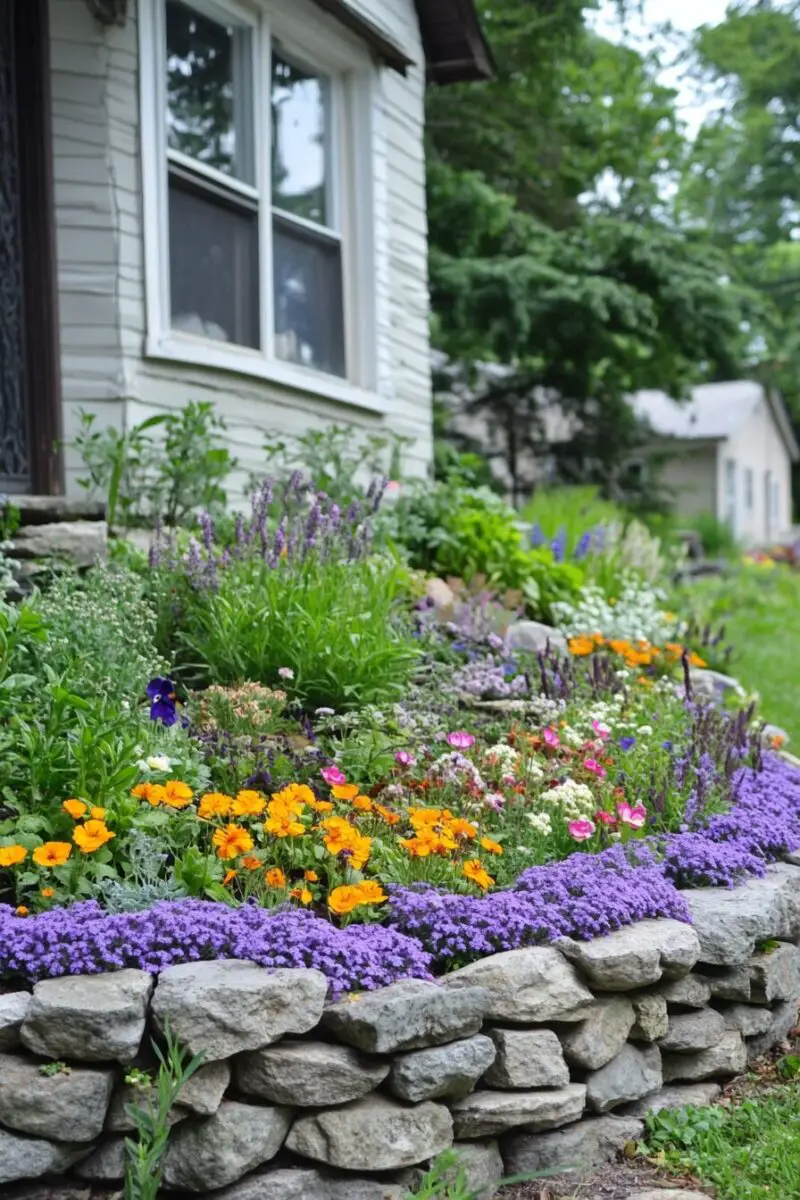
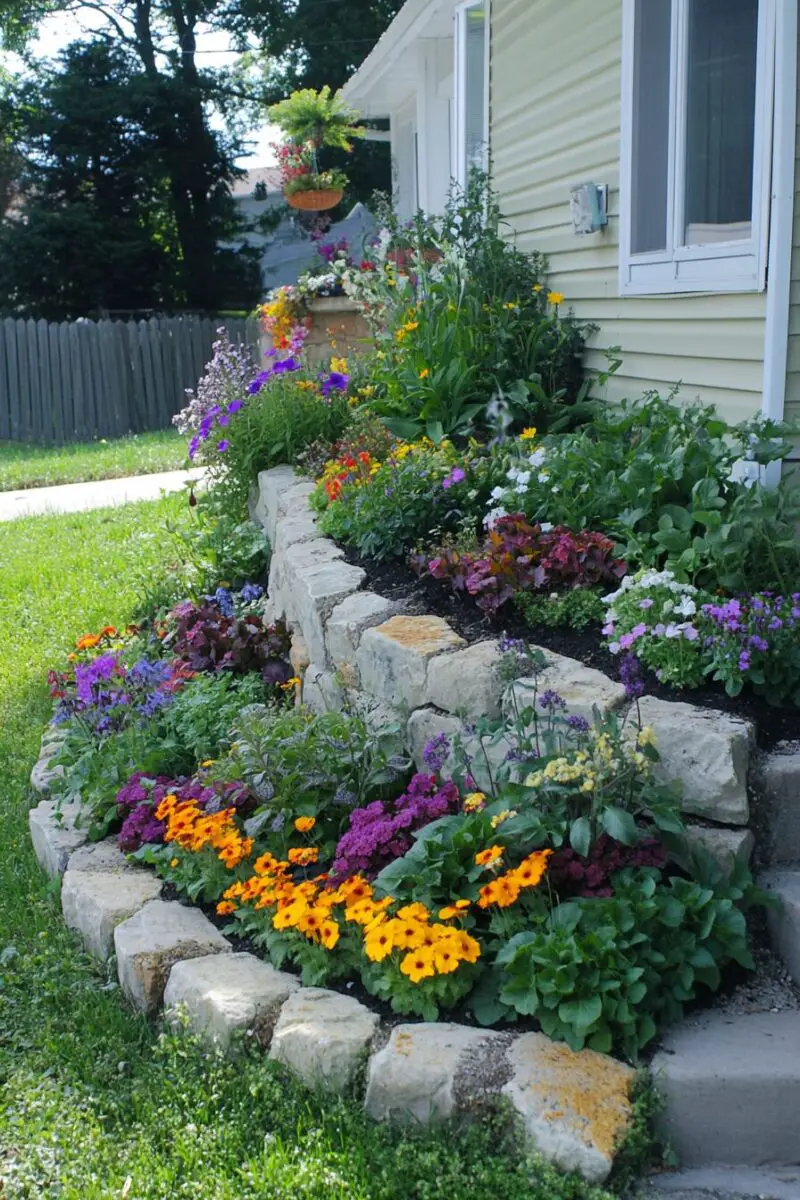
Sacred geometry meets practical gardening in the mesmerizing pattern of a stone spiral garden that transforms flat terrain into a three-dimensional masterpiece.
The spiral design isn’t just visually captivating – it’s actually an ingenious way to create multiple micro-climates in a single compact garden space.
Building a spiral garden begins with marking out a perfect circle in your front yard, then using stones or bricks to create a gradually rising spiral wall from the outer edge toward the center.
As the spiral wall rises toward the middle, it creates a natural planting area with excellent drainage at the top and moisture-retaining soil at the lower levels.
This clever design naturally accommodates both drought-tolerant plants at the elevated center and moisture-loving varieties along the lower edges.
Combining ornamental flowers with useful culinary herbs creates a garden that’s both beautiful and functional – a true conversation starter in your front yard.
Intersperse edible herbs with bright flowering plants like dianthus, compact marigolds, or dwarf zinnias to create an edible rainbow that delights both the eye and the palate.
The spiral pattern naturally guides visitors’ eyes inward toward the center, drawing attention to a special focal point like an unusual plant specimen or decorative garden ornament.
Height variation occurs naturally as the spiral rises, creating built-in visual interest without requiring plants of dramatically different sizes.
From the street view, a stone spiral garden makes a powerful artistic statement that distinguishes your home from every other property on the block.
The spiral shape holds deep symbolic meaning in many cultures, representing growth, evolution, and the journey inward – adding a subtle layer of meaning to your garden design.
Construction can use various materials – fieldstone creates a rustic look, while uniform bricks offer a more polished appearance that might better complement certain architectural styles.
Water features integrate beautifully with spiral gardens – a small bubbling fountain at the center or a gentle stream that follows the spiral path adds auditory pleasure to the visual experience.
✨Click to Get My 101 FREE Designer Room Ideas
Upcycled Vintage Container Garden
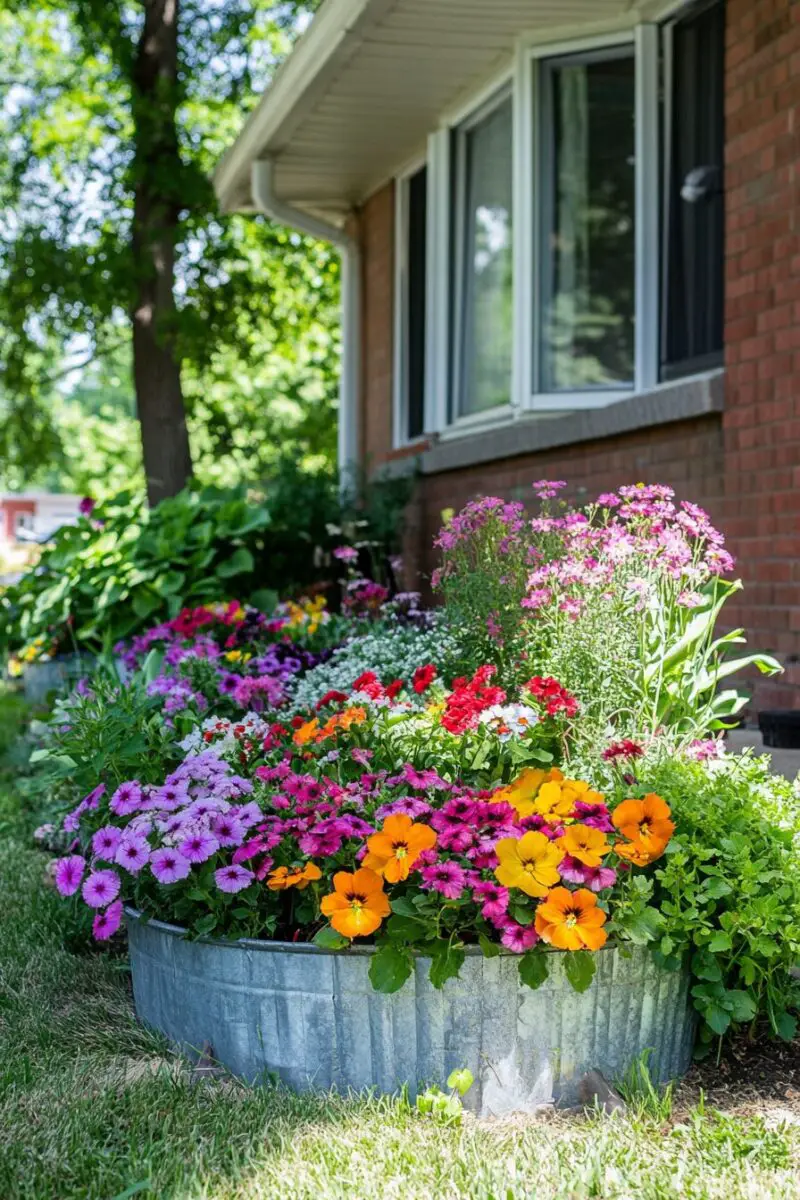
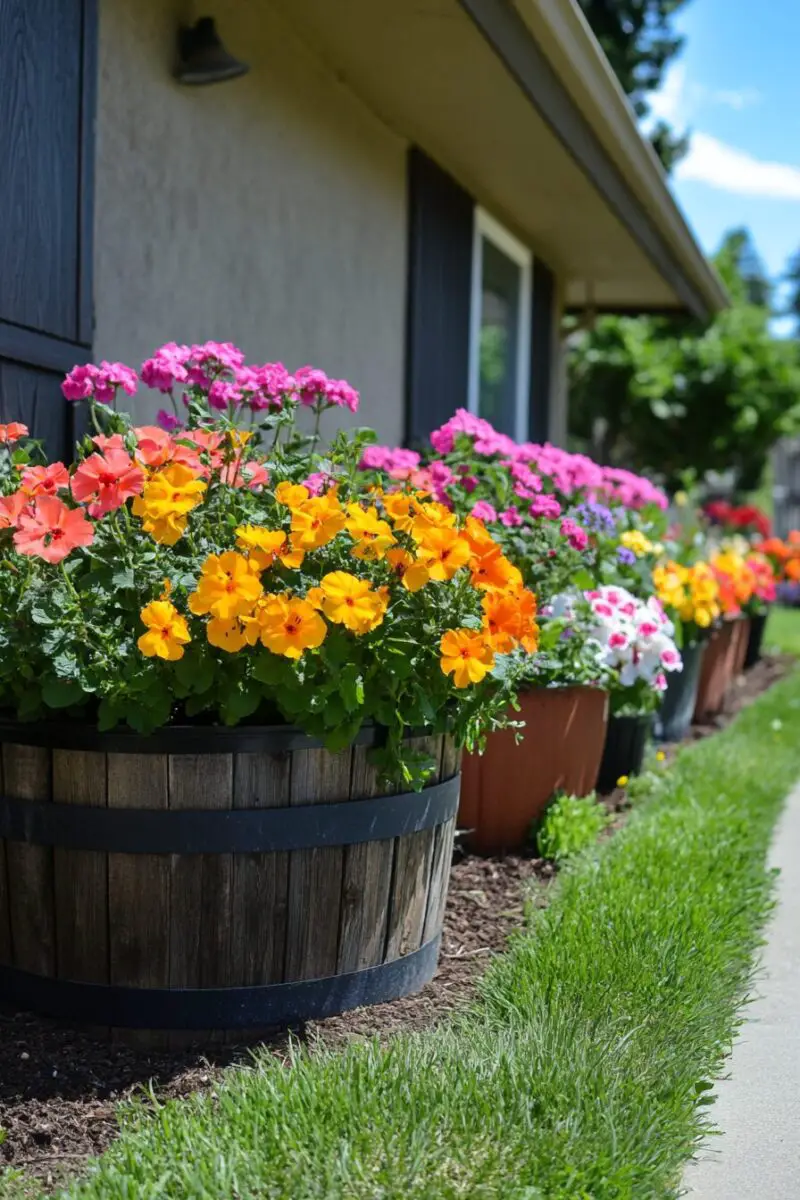
That collection of vintage treasures gathering dust in your attic holds the secret to creating the most unique front yard on your block.
Upcycled container gardens transform ordinary front spaces into extraordinary showcases of creativity and personality while giving new life to overlooked objects.
Almost anything that can hold soil can become a planter – vintage suitcases, antique metal washtubs, old dressers with drawers pulled out, or even that porcelain sink removed during your bathroom renovation.
The key to elevating this concept from random to remarkable lies in creating a cohesive theme – perhaps a collection of all-white containers, items from a specific era, or objects that tell your family’s story.
Drainage becomes your first consideration – drill holes in the bottom of containers or add a layer of gravel before soil to prevent waterlogging that can damage both plants and vintage items.
Position your containers thoughtfully to create a natural flow that guides visitors through your front garden space while showcasing each unique planter.
Height variation creates visual interest – place some containers directly on the ground while elevating others on stumps, small tables, or stacked bricks to create a multi-level display.
For maximum impact, group containers in odd numbers – collections of three or five create more visual appeal than symmetrical arrangements.
Plant selection should complement your containers – delicate flowers in feminine vintage pieces, structural plants in industrial containers, or trailing vines in elevated pieces.
Weather protection extends the life of your unique containers – a clear sealer on wooden items or rust protection on metal pieces preserves their beauty through changing seasons.
The stories behind your containers add another layer of interest – that trunk from great-grandma’s immigration journey now overflowing with native plants creates a powerful narrative in your front yard.
Lighting transforms this garden after dark – solar stake lights, string lights woven among plants, or spotlights highlighting special containers extend enjoyment into evening hours.
Seasonal changes keep your display fresh – swap tender summer annuals for cold-tolerant pansies and ornamental kale when temperatures drop, or add miniature evergreens for winter structure.
The inherent portability of container gardens allows easy rearrangement whenever inspiration strikes or when certain areas need more visual weight.
Geometric Concrete Block Planters
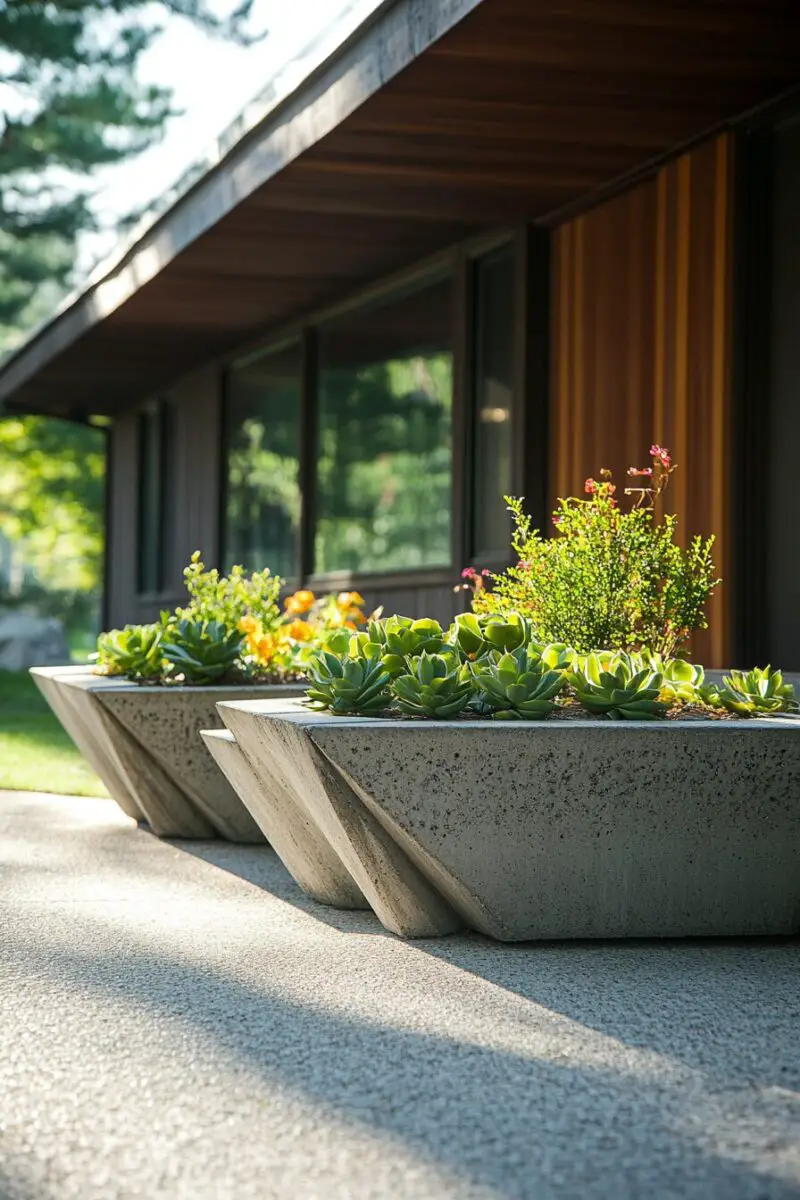

Industrial chic meets garden innovation with geometric concrete block planters that transform humble building materials into sculptural front yard art.
The raw, minimalist appeal of concrete blocks creates striking contrast against the soft organic shapes of plants and flowers.
This approach brings architectural interest to flat front yards through a modular system that can be configured endlessly according to your space and imagination.
Standard concrete blocks from any home improvement store become the building blocks of a completely customized garden feature that costs a fraction of professionally installed landscaping.
The open cells of concrete blocks create perfect planting pockets for individual specimens, allowing you to create living mosaic patterns across your front yard.
Configuration options range from simple stacked arrangements to complex geometric patterns that form retaining walls, raised beds, or freestanding garden dividers.
No mortar or permanent installation needed – simply arrange blocks in your desired pattern directly on level ground, making this perfect for renters or gardeners who enjoy changing their designs seasonally.
The uniform size of concrete blocks creates a pleasingly rhythmic pattern that brings order and intention to otherwise casual plantings.
For maximum visual impact, consider painting individual blocks in coordinating colors or a gradient pattern before arranging them in your garden space.
Plant selection becomes crucial with this style – choose specimens that create dramatic contrast against the hard lines of concrete, such as cascading succulents, ornamental grasses, or bright flowering annuals.
The block openings naturally create microclimates – some cells receive full sun while others remain partially shaded, allowing you to grow a wider variety of plants in close proximity.
Heat retention in concrete blocks creates excellent growing conditions for heat-loving plants like herbs and succulents, extending your growing season in cooler climates.
For modern home styles, this approach creates perfect architectural harmony by echoing clean lines and geometric precision in your landscape design.
Even traditional homes benefit from this unexpected juxtaposition of industrial elements with traditional architecture – creating refreshing visual tension.
Colorful Mosaic Stone Borders
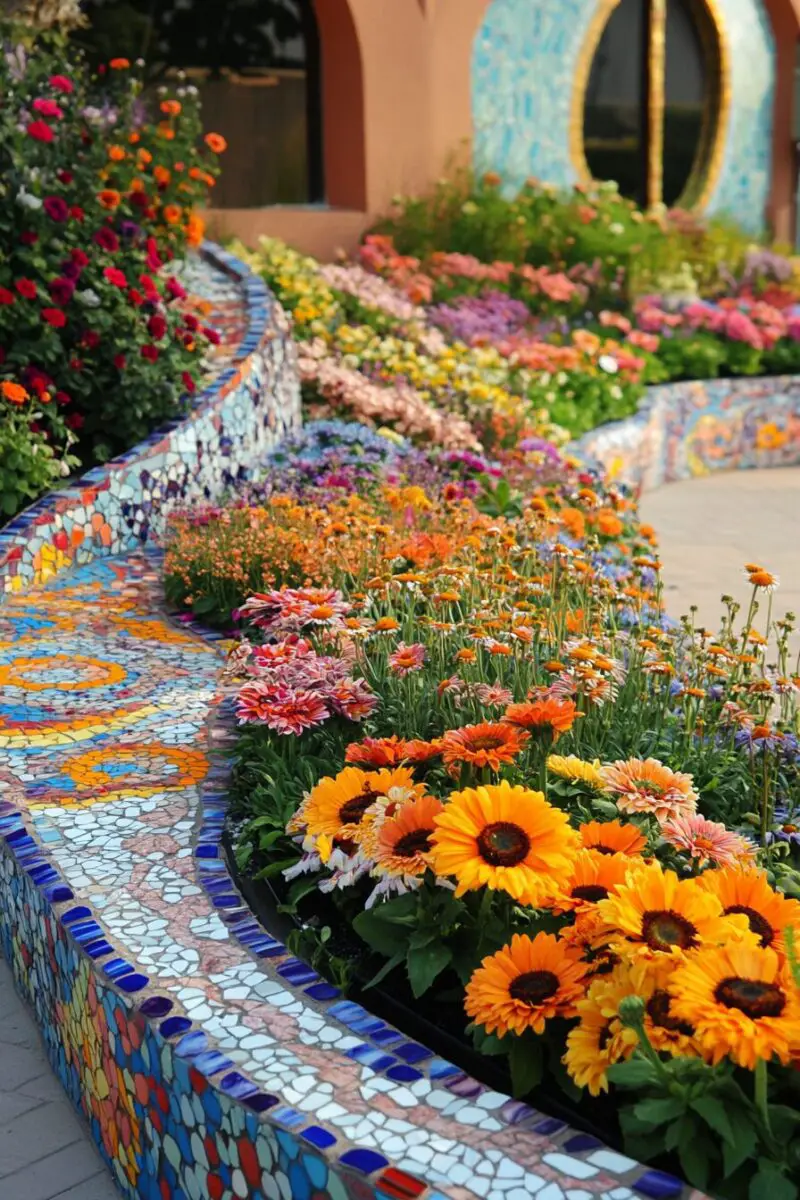
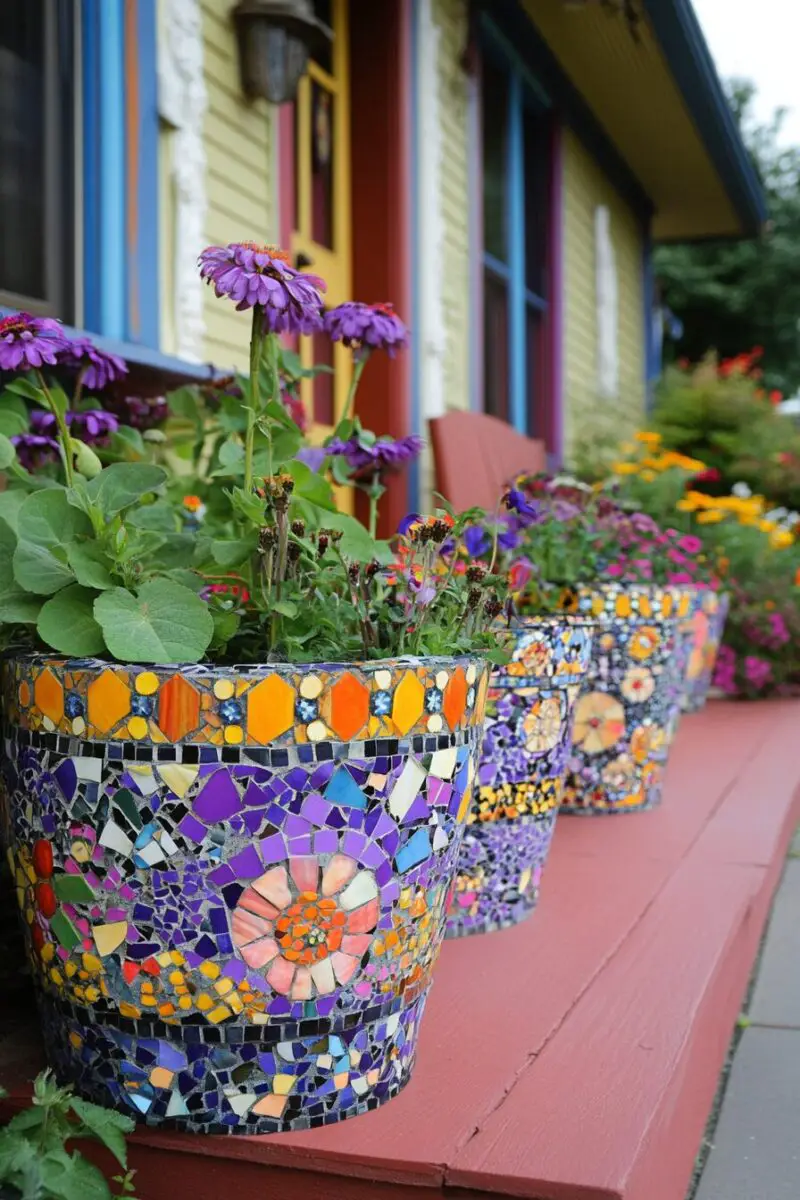
Ordinary garden borders transform into spectacular ribbons of color and pattern when you introduce hand-crafted mosaic stepping stones as functional art in your front yard.
These personalized garden elements create a flowing border that’s practical for garden access while doubling as a stunning artistic statement.
Creating your own mosaic stepping stones allows for complete customization – incorporating family names, special dates, favorite quotes, or abstract designs that reflect your personality.
The process becomes a wonderful family project, with each member designing their own stone to contribute to the collective garden border.
Materials remain remarkably affordable – concrete mix, colorful glass pieces, broken ceramic tiles, marbles, and even repurposed costume jewelry can all find new life in your mosaic creations.
Begin by forming a clearly defined path or border plan, then create stones to fit your specific measurements and garden contours.
Commercial stepping stone molds provide perfect uniformity, but repurposed items like large plastic container lids, old baking pans, or even cardboard boxes lined with plastic can serve as economical alternatives.
Color themes tie your mosaic border together – perhaps cool blues and greens for a serene garden feel, or vibrant reds and oranges for energetic visual impact.
The spaces between stepping stones become opportunities for additional interest – plant creeping thyme, Irish moss, or other low-growing ground covers that can withstand occasional foot traffic.
Your mosaic border naturally guides visitors through your garden space while protecting plants from being trampled.
Weather resistance ensures your artwork lasts for years – apply concrete sealer to protect your finished stones from freeze-thaw cycles and moisture damage.
Nighttime brings another dimension to this garden feature – solar-powered lights placed strategically between stones create a magical illuminated pathway after sunset.
For cohesive design, incorporate colors from your home’s exterior into your mosaic patterns, creating visual harmony between house and garden.
These personalized stepping stones often become beloved family heirlooms, marking special occasions and preserving memories directly in your landscape.
Terraced Retaining Wall Garden
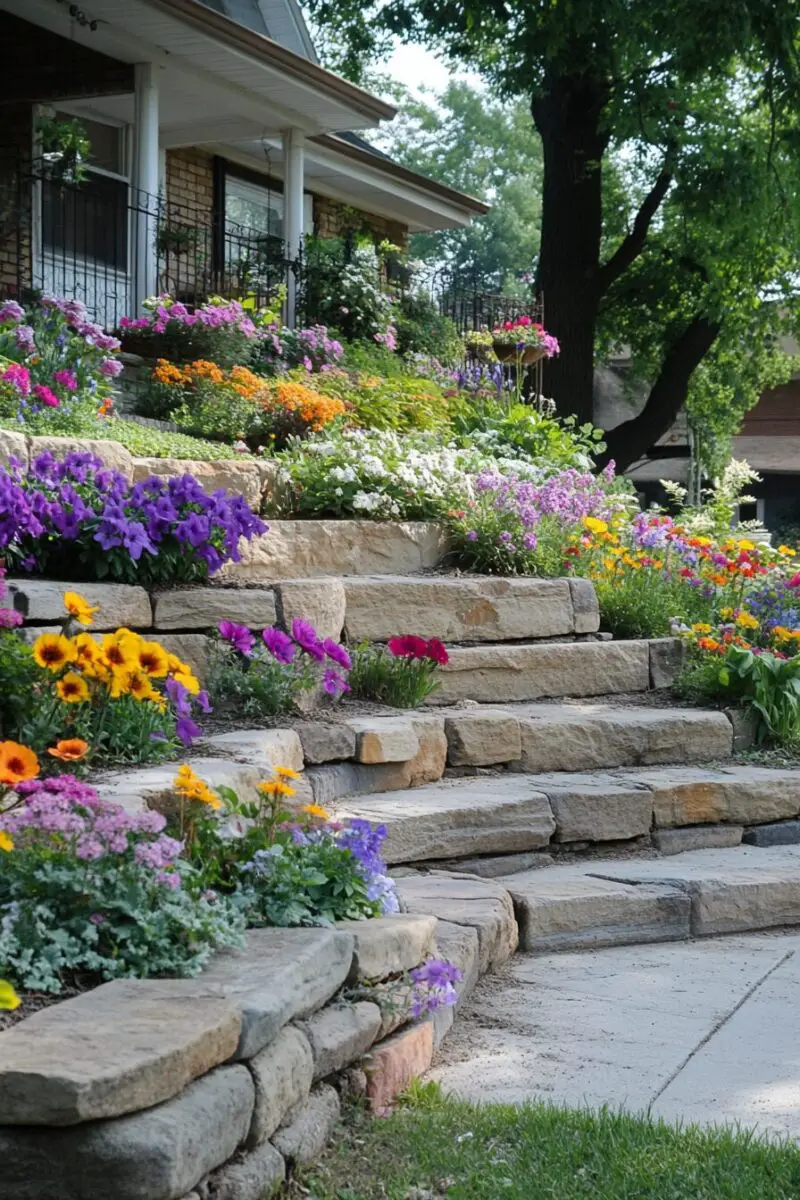
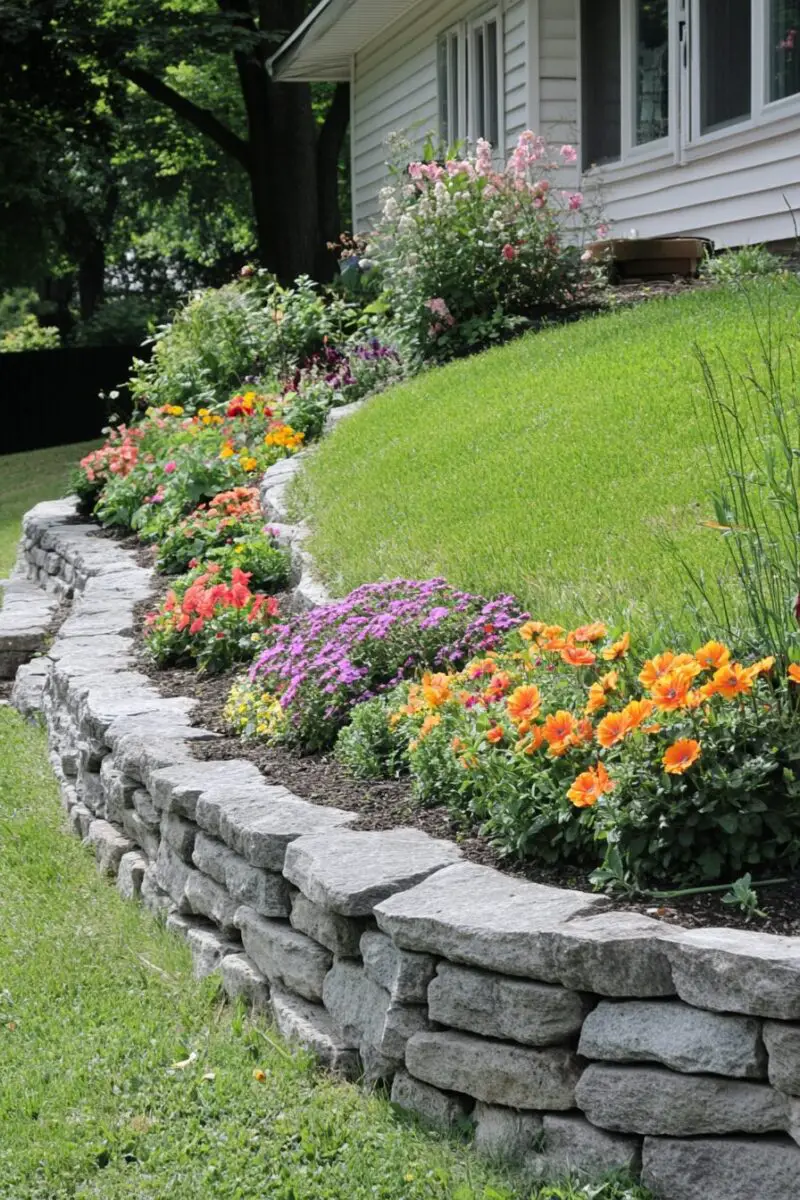
That sloped front yard that’s been nothing but a mowing hazard transforms into your property’s greatest asset when reimagined as a terraced garden.
Terraced retaining walls convert problematic slopes into a series of level planting areas that prevent erosion while creating dramatic visual impact from the street.
The elevated design naturally draws the eye upward, making even modest plantings appear more substantial and giving your front yard a sense of expanded space.
Construction materials offer endless possibilities – stack natural stone for a rustic look, use manufactured blocks for clean contemporary lines, or incorporate railroad ties for industrial charm.
Each terrace level creates a distinct microclimate, allowing you to grow plants with different sun, soil, and moisture needs in close proximity.
The highest terrace typically receives the most sun exposure, making it ideal for drought-tolerant plants, while lower levels retain more moisture for shade-loving specimens.
Height variation occurs naturally with this design, creating built-in visual interest as plants at different elevations interact with each other across the terraces.
Water management improves dramatically – terraced gardens slow runoff, reduce erosion, and allow rainfall to penetrate soil rather than racing down slopes.
Plant selection should consider viewing angles – taller specimens work well on lower terraces while shorter plants can occupy higher levels for optimal visibility from all perspectives.
Color coordination across terraces creates cohesion – consider a gradient effect with cool colors on upper levels transitioning to warmer tones below.
Incorporate built-in seating on one terrace level to create a natural viewing platform for enjoying the entire garden display.
Cascading plants that spill over retaining walls soften hard edges and create visual connection between terraces – think creeping phlox, wave petunias, or ornamental strawberry.
Structural elements like decorative boulders, driftwood, or garden art placed strategically among plantings add year-round interest even when flowers aren’t in bloom.
The natural layers of terraces create perfect opportunity for seasonal succession planting – early spring bulbs on one level, summer perennials on another, and fall-blooming asters on a third terrace.
Lighting transforms terraced gardens after dark – subtle uplighting against retaining walls creates dramatic shadows, while path lights ensure safe navigation between levels.
✨Click to Get My 101 FREE Designer Room Ideas
Rain Boot or Shoe Flower Display
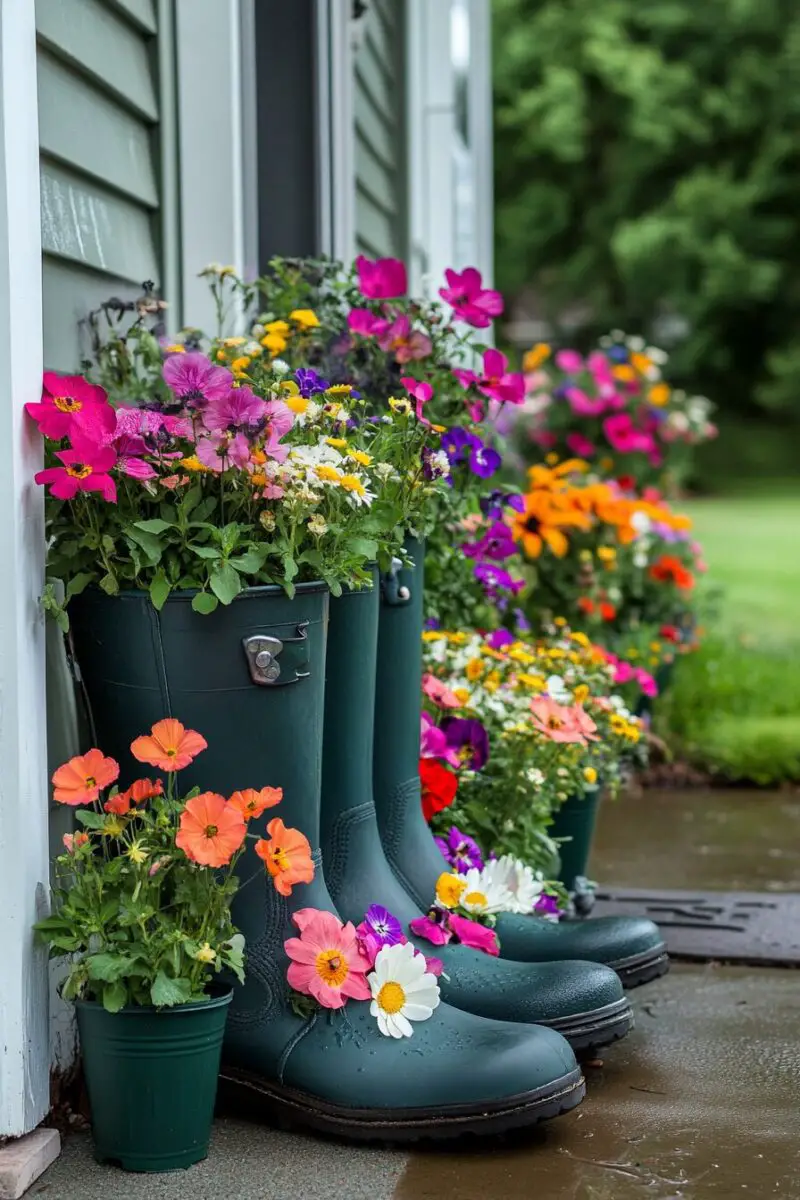
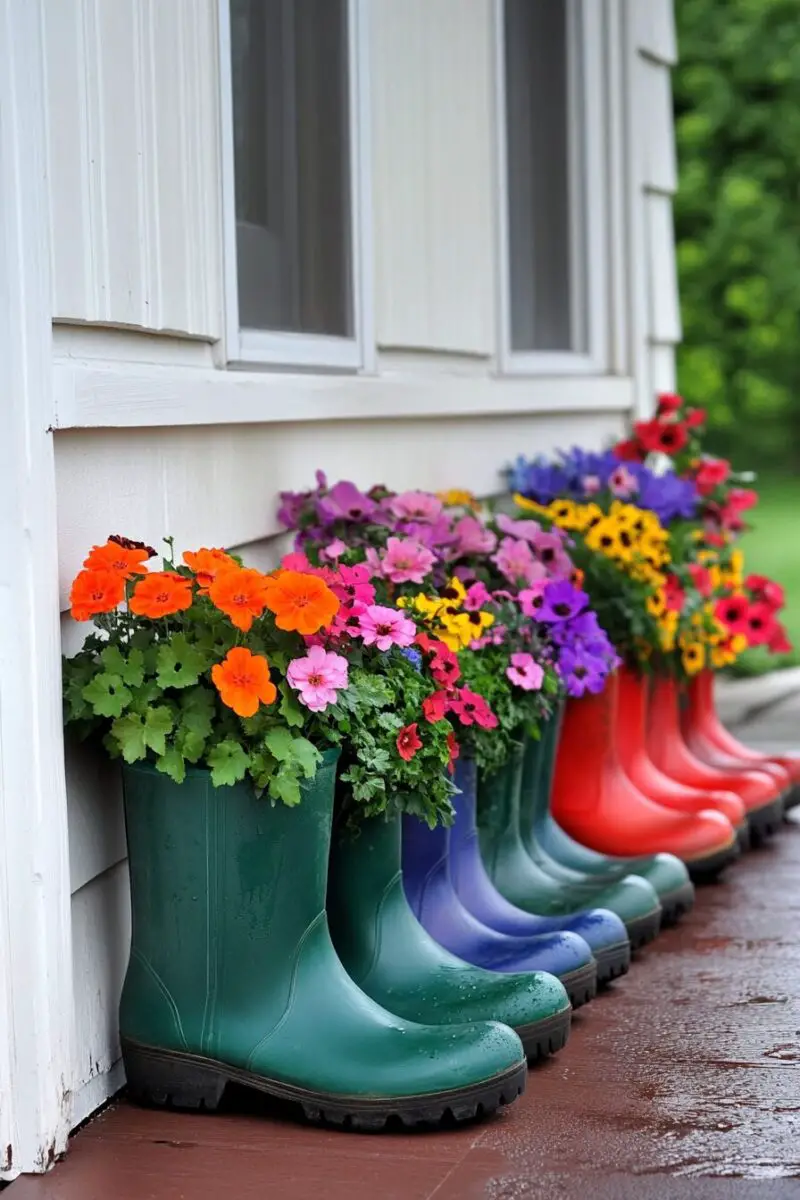
That collection of outgrown rain boots, worn-out work shoes, or colorful clogs hiding in your closet holds the secret to creating the most smile-inducing garden on your block.
Whimsical footwear planters inject personality, humor, and unexpected charm into front gardens that might otherwise blend into neighborhood sameness.
The concept resonates particularly well with families – children delight in seeing outgrown boots transformed into flowering treasures rather than discarded.
Creating drainage becomes your first step – drill several holes in the bottom of each shoe or boot to prevent waterlogging that would damage both footwear and plants.
Arrangement possibilities range from climbing installations where boots hang at varying heights on a trellis or fence, to ground-level “walking paths” where planted footwear appears to stroll through your garden.
Collection themes enhance visual impact – perhaps all red shoes, a rainbow progression of colors, or a chronological journey from baby booties to adult work boots telling your family’s story.
Plant selection should complement your container choices – delicate ferns and impatiens for feminine shoes, while sturdy succulents and ornamental grasses suit more rugged footwear.
Trailing plants that spill over boot tops create natural softening effects – sweet potato vine, creeping Jenny, or cascading petunias work particularly well.
Position your footwear garden where it’s easily visible from the street, perhaps flanking your front walkway or arranged on front porch steps for maximum enjoyment.
Weather exposure affects longevity – leather shoes deteriorate quickly outdoors, while rubber boots and synthetic footwear withstand elements much longer.
Seasonal refreshes keep this garden feature looking its best – swap heat-loving summer annuals for cold-tolerant pansies when temperatures drop.
For cohesive design impact, coordinate flower colors with the shoes themselves – perhaps yellow blossoms spilling from yellow rain boots, or purple petunias from lavender clogs.
The inherent portability of this garden style allows easy rearrangement whenever inspiration strikes or when certain areas need visual reinforcement.
Living Furniture Garden
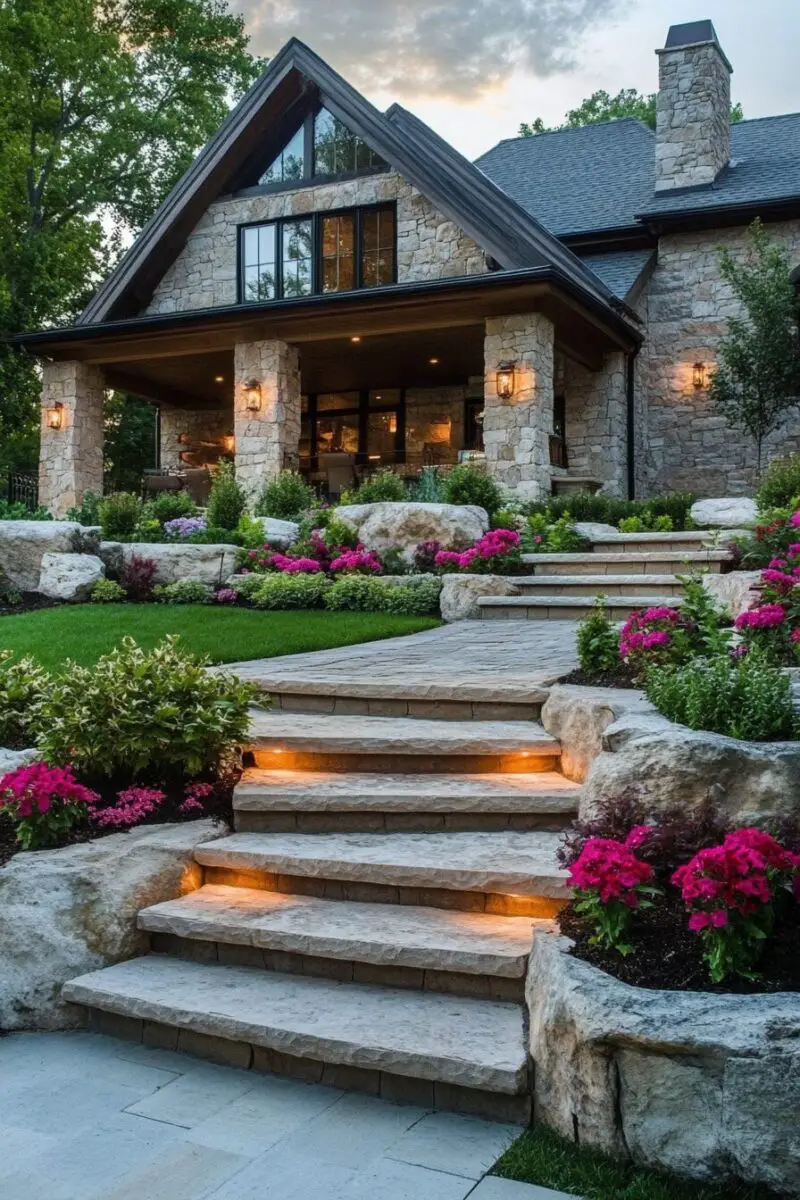
Imagine garden furniture that never needs painting, naturally improves with age, and actually contributes to local ecology – living furniture gardens deliver all this while creating unforgettable front yard focal points.
The concept transforms ordinary garden spaces into fantastical wonderlands where chairs, benches, and tables sprout flowers instead of holding afternoon tea.
Creating living furniture begins with simple wire frames formed into furniture shapes, then stuffed with soil-filled moss and planted with cascading flowers and ground covers.
For more permanent installations, start with wooden furniture forms, line with landscape fabric, then fill with soil to create stable planting surfaces.
Structural plants like small boxwoods, compact junipers, or dense sedges create “bones” for your furniture pieces, while flowering plants add seasonal color and interest.
When selecting plants, consider texture as much as color – combining feathery ferns, strappy ornamental grasses, and round-leafed succulents creates rich visual complexity.
Position your living furniture thoughtfully – perhaps a chair and side table vignette near your front entry, or a complete “living room set” as your main garden focal point.
The whimsical nature of this garden style particularly suits cottages, craftsman bungalows, and other architectural styles with inherent charm and character.
Functionality remains optional – some gardeners create sturdy furniture that actually supports weight, while others focus purely on ornamental pieces.
For weight-bearing pieces, incorporate solid internal structure like concrete blocks inside soil-filled chairs, then cover with landscape fabric before adding plants.
Seasonal transformations keep living furniture gardens interesting year-round – spring bulbs give way to summer annuals, followed by fall color from sedums and ornamental kale.
Maintenance requirements vary by climate – drought-prone regions should focus on succulents and native plants, while rainy areas can support more moisture-loving varieties.
Water conservation becomes a consideration – incorporate drip irrigation into your furniture forms to deliver water directly to plant roots with minimal waste.
The three-dimensional nature of living furniture creates perfect photography opportunities – these whimsical creations inevitably become the backdrop for family photos and social media moments.
Front yard gardens reflect your personality before visitors even reach your door, so why settle for conventional when you could create something truly memorable?
These ten unique approaches prove that imagination matters more than budget when transforming ordinary spaces into extraordinary gardens.
Remember that the most successful garden designs combine personal meaning with visual impact – creating spaces that tell your story while delighting everyone who passes by.
The best part about creative DIY gardens?
They evolve with you – expanding, changing, and growing more interesting with each passing season.

